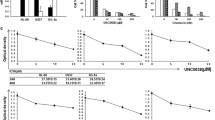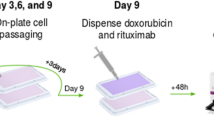Abstract
The process of cancer initiation and development is regulated via the transcriptional expression of cells going under genomic and epigenetic changes. Targeting epigenetic “readers”, i.e., bromodomains (BRD) and post-translational modifications of nucleosomal histone proteins regulate gene expression in both cancerous and healthy cells. In this study, the new epigenetic agent BRD inhibitor PLX51107 and histone deacetylase (HDAC) inhibitor SAHA’ s (Vorinostat) single/combined applications’ reflections were analyzed in case of cell proliferation, cytotoxicity, apoptosis, cell cycle arrest, and finally target gene expression regulation upon both AML and healthy B-lymphocyte cells; HL60 and NCIBL2171, respectively; in vitro. Since mono treatments of either Vorinostat or Plx51107 regulated cellular responses such as growth, proliferation, apoptosis, and cell cycle arrest of tumor cells; their combination treatments exerted accelerated results. We detected that combined treatment of Plx51107 and Vorinostat strengthened effects detected upon leukemic cells for gaining more sensitization to the agents, decreasing cell proliferation, dramatically inducing apoptosis, and cell cycle arrest; thus regulating target gene expressions. We have shown for the first time that the newly analyzed BRD inhibitor Plx51107 could be a promising therapeutic approach for hematological malignancies and its mono or combined usage might support a rapid transition to clinical trials.










Similar content being viewed by others
Data availability
The datasets generated analyzed during the current study are available from the corresponding author on reasonable request.
Consent to publish
Since this article does not include any studies with human participants or animals, an informed consent form is not required.
References
Abedin SM, Boddy CS, Munshi HG. BET inhibitors in the treatment of hematologic malignancies: current insights and prospects. OncoTargets Ther. 2016. https://doi.org/10.2147/OTT.S100515.
Attia SM, Al-Khalifa MK, Al-Hamamah MA, Alotaibi MR, Attia MSM, Ahmad SF, et al. Vorinostat is genotoxic and epigenotoxic in the mouse bone marrow cells at the human equivalent doses. Toxicology. 2020. https://doi.org/10.1016/j.tox.2020.152507.
Boi M, Gaudio E, Bonetti P, Kwee I, Bernasconi E, Tarantelli C, et al. The BET bromodomain inhibitor OTX015 affects pathogenetic pathways in preclinical B-cell tumor models and synergizes with targeted drugs. Clin Cancer Res. 2015;21(7):1628–38.
Cengiz Seval G, Beksac M. A comparative safety review of histone deacetylase inhibitors for the treatment of myeloma. Expert Opin Drug Saf. 2019. https://doi.org/10.1080/14740338.2019.1615051.
Chen X, Burkhardt DB, Hartman AA, Hu X, Eastman AE, Sun C, et al. MLL-AF9 initiates transformation from fast-proliferating myeloid progenitors. Nat Commun. 2019;10(1):1–15.
Čokić VP, Mojsilović S, Jauković A, Kraguljac-Kurtović N, Mojsilović S, Šefer D, et al. Gene expression profile of circulating CD34+ cells and granulocytes in chronic myeloid leukemia. Blood Cells Mol Dis. 2015;55(4):373–81.
Coudé MM, Braun T, Berrou J, Dupont M, Bertrand S, Masse A, et al. BET inhibitor OTX015 targets BRD2 and BRD4 and decreases c-MYC in acute leukemia cells. Oncotarget. 2015;6(19):17698.
Dalva K. Hematopoez. Türk Klinik Biyokimya Sempozyumu. Denizli. Erişim adresi (2018). http://tkb.dergisi.org/pdf/pdf_TKB_317.pdf
De Kouchkovsky I, Abdul-Hay M. Acute myeloid leukemia: a comprehensive review and 2016 update. Blood Cancer J. 2016. https://doi.org/10.1038/bcj.2016.50.
Fasouli ES, Katsantoni E. JAK-STAT in early hematopoiesis and leukemia. Front Cell Dev Biol. 2021;9: 669363. https://doi.org/10.3389/fcell.2021.669363.
Fong CY, Gilan O, Lam EY, Rubin AF, Ftouni S, Tyler D, et al. BET inhibitor resistance emerges from leukemia stem cells. Nature. 2015;525(7570):538.
Ge W, Liu Z, Sun Y, Wang T, Guo H, Chen X, et al. Design and synthesis of parthenolide-SAHA hybrids for the intervention of drug-resistant acute myeloid leukemia. Bioorg Chem. 2019;87:699–713. https://doi.org/10.1016/j.bioorg.2019.03.056.
Hassell. Histone deacetylases and their inhibitors in cancer epigenetics. Diseases. 2019;7(4):57. https://doi.org/10.3390/diseases7040057.
Huang CS, Tan M, Zhang XM, Luo X, Tian RM, Su Q, et al. Expression and clinical significance of STAT3 genes in patients with acute myeloid leukemia. Zhongguo Shi Yan Xue Ye Xue Za Zhi. 2019;27(1):45–51.
Iacobucci I. GATA-related hematologic disorders. Exp Hematol. 2016;44(8):696–705.
Ivanov M, Barragan I, Ingelman-Sundberg M. Epigenetic mechanisms of importance for drug treatment. Trends Pharmacol Sci. 2014. https://doi.org/10.1016/j.tips.2014.05.004.
José-Enériz ES, Gimenez-Camino N, Agirre X, Prosper F. HDAC inhibitors in acute myeloid leukemia. Cancers. 2019. https://doi.org/10.3390/cancers11111794.
Jostes S, Nettersheim D, Schorle H. Epigenetic drugs and their molecular targets in testicular germ cell tumors. Nat Rev Urol. 2019;16(4):245–59.
Kayser S, Levis MJ. Advances in targeted therapy for acute myeloid leukemia. Br J Hematol. 2018;180(4):484–500.
Khangura RK, Bali A, Jaggi AS, Singh N. Histone acetylation and histone deacetylation in neuropathic pain: an unresolved puzzle? Eur J Pharmacol. 2017. https://doi.org/10.1016/j.ejphar.2016.12.001.
Krönke J, Kuchenbauer F, Kull M, Teleanu V, Bullinger L, Bunjes D, et al. IKZF1 expression is a prognostic marker in newly diagnosed standard-risk multiple myeloma treated with lenalidomide and intensive chemotherapy: a study of the German Myeloma Study Group (DSMM). Leukemia. 2017;31(6):1363–7.
Liu S, Li F, Pan L, Yang Z, Shu Y, Lv W, et al. BRD4 inhibitor and histone deacetylase inhibitor synergistically inhibit the proliferation of gallbladder cancer in vitro and in vivo. Cancer Sci. 2019;110(8):2493–506.
Mao J, Li S, Zhao H, Zhu Y, Hong M, Zhu H, et al. Effects of chidamide and its combination with decitabine on proliferation and apoptosis of leukemia cell lines. Am J Transl Res. 2018;10(8):2567–78.
Mertz JA, Conery AR, Bryant BM, Sandy P, Balasubramanian S, Mele DA, et al. Targeting MYC dependence in cancer by inhibiting BET bromodomains. Proc Natl Acad Sci USA. 2011;108(40):16669–74. https://doi.org/10.1073/pnas.1108190108.
Moore LD, Le T, Fan G. DNA methylation and its basic function. Neuropsychopharmacology. 2013. https://doi.org/10.1038/npp.2012.112.
Nikbakht N, Tiago M, Erkes DA, Chervoneva I, Aplin AE. BET inhibition modifies melanoma infiltrating T cells and enhances response to PD-L1 blockade. J Investig Dermatol. 2019;139(7):1612.
Orkin SH. Transcription factors and hematopoietic development. J Biol Chem. 1995;270(10):4955–8.
Pérez-Salvia M, Esteller M. Bromodomain inhibitors and cancer therapy: from structures to applications. Epigenetics. 2017;12(5):323–39. https://doi.org/10.1080/15592294.2016.1265710.
Pericole FV, Lazarini M, De Paiva LB, Duarte ADSS, Vieira Ferro KP, Niemann FS, et al. BRD4 inhibition enhances azacitidine efficacy in acute myeloid leukemia and myelodysplastic syndromes. Front Oncol. 2019;9:16.
Ramadoss M, Mahadevan V. Targeting the cancer epigenome: synergistic therapy with bromodomain inhibitors. Drug Discov Today. 2018. https://doi.org/10.1016/j.drudis.2017.09.011.
Sarnik J, Popławski T, Tokarz P. BET proteins as attractive targets for cancer therapeutics. Int J Mol Sci. 2021;22(20):11102.
Silva G, Cardoso BA, Belo H, Almeida AM. Vorinostat induces apoptosis and differentiation in myeloid malignancies: genetic and molecular mechanisms. PLoS ONE. 2013;8(1): e53766.
Shallis RM, Wang R, Davidoff A, Ma X, Zeidan AM. Epidemiology of acute myeloid leukemia: recent progress and enduring challenges. Blood Rev. 2019;36:70–87.
Shimizu R, Yamamoto M. GATA-related hematologic disorders. Exp Hematol. 2016;44(8):696–705. https://doi.org/10.1016/j.exphem.2016.05.010 (Epub 25 May 2016).
Stewart HJS, Horne GA, Bastow S, Chevassut TJT. BRD4 associates with p53 in DNMT3A-mutated leukemia cells and is implicated in apoptosis by the bromodomain inhibitor JQ1. Cancer Med. 2013;2:826–35.
Stewart HJS, Shalit E, Halliday L, Morey D, Chevassut TJ. Acute myeloid leukemia cells exhibit selective down-regulation of DNMT3A isoform 2. Leuk Lymphoma. 2015. https://doi.org/10.3109/10428194.2015.1032965.
Strauss J, Figg WD. Using epigenetic therapy to overcome chemotherapy resistance. Anticancer Res Int Inst Anticancer Res. 2016;36(1):1–4.
Sun CC, Li SJ, Chen ZL, Li G, Zhang Q, Li DJ. Expression and prognosis analyses of runt-related transcription factor family in human leukemia. Mol Ther Oncolytics. 2019;12:103–11. https://doi.org/10.1016/j.omto.2018.12.008.
Sun Y, Wang H, Luo C. miR-100 regulates cell viability and apoptosis by targeting ATM in pediatric acute myeloid leukemia. Biochem Biophys Res Commun. 2019. https://doi.org/10.1016/j.bbrc.2019.11.156.
Taniguchi Y. The bromodomain and extra-terminal domain (BET) family: functional anatomy of BET paralogous proteins. Int J Mol Sci. 2016. https://doi.org/10.3390/ijms17111849.
Wen JC, Jiang T, Bao Y, Lin XJ, Wang WQ, Liu D, Zhao LX. Synthesis and antitumor activity of S-hexyl (heptyl) substituted ethanethioate derivatives. Yao xue xue bao = Acta Pharm Sin. 2014;49(3):352–8.
Young CS, Clarke KM, Kettyle LM, Thompson A, Mills KI. Decitabine-Vorinostat combination treatment in acute myeloid leukemia activates pathways with potential for novel triple therapy. Oncotarget. 2017;8(31):51429.
Zhao X, Liu H, Wang L, Yang L, Liu X. Current and emerging molecular and epigenetic disease entities in acute myeloid leukemia and a critical assessment of their therapeutic modalities. Semin Cancer Biol. 2020. https://doi.org/10.1016/j.semcancer.2020.11.010.
Acknowledgements
This study was supported by Ege University Scientific Research Projects Coordinatorship referred to as TGA-2019-20763. All of the experimental studies were carried out in Ege University Medical Biology Department Laboratories.
Funding
This study was funded by Ege University Scientific Research Projects Coordinatorship referred to as TGA-2019-20763.
Author information
Authors and Affiliations
Contributions
HS and IA performed cell culture and follow-up. HS, IA, and IK performed cytotoxicity and apoptosis analysis of the agents on leukemia and non- leukemia cells. BTK determined gene expression changes by qRT-PCR and performed statistical analysis. IA and BTK has written the paper; BTK as the supervisor.
Corresponding author
Ethics declarations
Conflict of interest
All authors declare that they have no conflict of interest.
Ethical approval
This article does not contain any studies with human participants or animals performed by the author IA and BTK.
Informed consent
As the study was in vitro, informed consent was not required.
Additional information
Publisher's Note
Springer Nature remains neutral with regard to jurisdictional claims in published maps and institutional affiliations.
Rights and permissions
Springer Nature or its licensor holds exclusive rights to this article under a publishing agreement with the author(s) or other rightsholder(s); author self-archiving of the accepted manuscript version of this article is solely governed by the terms of such publishing agreement and applicable law.
About this article
Cite this article
Alcitepe, İ., Salcin, H., Karatekin, İ. et al. HDAC inhibitor Vorinostat and BET inhibitor Plx51107 epigenetic agents’ combined treatments exert a therapeutic approach upon acute myeloid leukemia cell model. Med Oncol 39, 257 (2022). https://doi.org/10.1007/s12032-022-01858-x
Received:
Accepted:
Published:
DOI: https://doi.org/10.1007/s12032-022-01858-x




